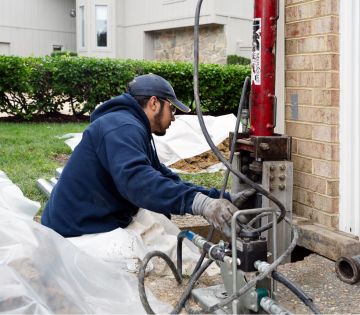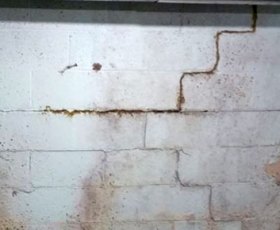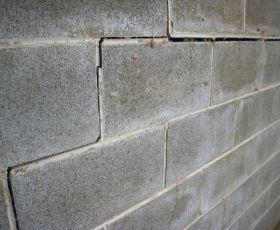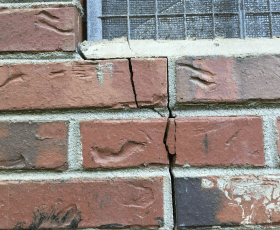Problem Signs
Is there a crack in the wall you’ve been meaning to fix but kept putting it off? Don’t let it go too long. The longer you put off addressing the problem, the more involved and expensive the repair is going to be. And your safety and your loved ones’ wellbeing will be in danger. Why expose your family to a hazardous and unsafe home?
Ohio Basement Authority

Wall Crack
Foundation wall cracks have several different causes, and each has its own unique solution.
Ohio Basement Authority

Uneven Floor
Uneven floors are rarely caused by problems with the floor system itself. Instead, it’s often a settling or shifting foundation issue that has impacted the floor system.
Ohio Basement Authority

Sticking Windows & Doors
Any opening made in a wall represents a weak point. This is especially true for load-bearing exterior walls. That’s why foundation settlement will often cause cracks around window and door openings.
Ohio Basement Authority

Bowing Walls
Foundation walls move inward primarily due to expansive soils and hydrostatic pressure on the walls from outside.
Causes
Your house could be experiencing the above foundation problem signs and symptoms for a variety of reasons. But the biggest offender is the ground your house was built on. The soil under and around your home, as well as the health of that soil, has a big impact on your house.
After your home’s foundation was completed, previously excavated soil was backfilled to fill in the gap between the walls and the rest of the ground. This soil is loose, fluffy, and not as dense or tightly packed as undisturbed virgin soil farther away from the house. When water saturates this soil immediately surrounding the home, it creates a “clay bowl” of sorts. The saturated soil expands, exerting pressure on foundation walls known as hydrostatic pressure. When the force of this constant pressure becomes more than the walls can handle, they will begin to crack and tilt inward.
As the backfilled soil around your exterior foundation walls sinks into place, it can slope towards the house. This allows water to easily collect and then seep in through the walls.
It is natural for soil to settle over time, but it can do so unevenly and cause a number of other problems in your house. You could see diagonal cracks in drywall and from corners of windows and doors. These windows and doors also may not open or close properly.
Another more dramatic and alarming sign of soil settlement is a chimney that is cracking and separating from the home. Sometimes chimneys are not built on the same foundation or soil as the rest of the house, and they may not have the proper footing. If the chimney is not properly supported, it will fail over time. If the soil supporting your chimney isn’t strong enough to support the weight, the chimney may start sinking, pulling away from the rest of the home and tilt outward.
Related to the clay bowl effect and hydrostatic pressure, water can easily seep inside a crawl space underneath a house through the walls. Outside air, water and pests also can infiltrate an unsealed dirt crawl space through open vents. Any water and moisture in the crawl space can wreak havoc on the home’s support system. Metal supports can rust and corrode, and wooden supports will rot, warp, and buckle, all leading to sagging and soft floors above.
Solutions
Whether your home is experiencing structural damage from foundation settlement, hydrostatic pressure, soil washout, frost, or some other force, Ohio Basement Authority has the products that you need to permanently solve your problem and restore value to your home.
Ohio Basement Authority

Foundation Piers
Strong and stable. Our pier system will permanently solve your foundation settlement problem.
Ohio Basement Authority

Wall Anchor System
The Wall Anchor System permanently stabilizes your foundation walls, offering the best opportunity to straighten the walls without the cost and disruption of foundation replacement.
Ohio Basement Authority

Wall Reinforcing Systems
Stronger than steel, hi-tech carbon fiber reinforcement can provide a permanent repair for cracked & bowed basement walls
Ohio Basement Authority

Channel Anchor
The Channel Anchor System permanently stabilizes and repairs bowing or tilting foundation walls — without the cost and disruption of total foundation replacement.

FAQs
If your foundation is failing, there are various problem signs you’ll notice throughout your home. Do any of these issues sound familiar?
- Bowing Walls
- Wall Cracks (Vertical, Horizontal, Diagonal, Stair-Step)
- Collapsing Retaining Walls
- Floor Crack
- Uneven Floor
- Sagging Crawl Space
- Foundation Settlement
- Tilting Chimney
- Sticking Windows & Doors
Your house could be experiencing the above foundation problem signs and symptoms for a variety of reasons. But the biggest offender is the ground your house was built on. The soil under and around your home, as well as the health of that soil, has a big impact on your house.
There are so many kinds of soil types throughout the country, including hundreds in Ohio. But there are three basic ingredients – sand, silt, and clay, or a combination of any or all of these – that contribute to soil types and their textures. Maps from NASA Earth Observatory show how much of these ingredients can be found across the United States. Sandy soils that tend to drain water faster can be found in southern states, clay soils that hold onto water and silt soils that tend to have intermediate drainage properties can be found across the country.
Ohio has a good mix of all three ingredients. The state soil is Miamian soil, which has more silt. But Ohio also is rich in clay soil. So, various areas of the state will have more well-drained soil as opposed to others with expansive clay soils. To get a better idea what kind of soil you are dealing with, you can search your county and address in the Web Soil Survey from the United States Department of Agriculture Natural Resources Conservation Service.
Maybe the better question is “how can you not benefit from foundation repair?” There are so many reasons why fixing foundation problems is good for you, your family, and your house, but here are two major benefits:
- Protecting Your Safety and Your Home’s Structural Integrity — A house that is falling victim to hydrostatic pressure and cracks is not safe or structurally secure. Are you comfortable with putting your safety and that of your family at risk? Take back your home by having it repaired and protected with trusted solutions before it’s too late and you lose your home completely. You may have other renovations or projects you’d like to check off your list, but remember common phrases about having a strong foundation, and focus your efforts from the bottom up.
- Improving Your Home’s Real Estate Value — Even if you have your heart set on living in your house for the rest of your life or whether you plan to sell in the near future, you need to make sure your home will be ready before it goes on the market. Most home buyers have certain expectations such as worry-free homes that do not have issues like foundation cracks that they would have to deal with. Foundation problems can reduce your home’s resale value by 10 to 30 percent, and home buyers could have problems getting a mortgage. A safe and stable home is more attractive to buyers as opposed to a house with cracks and uneven floors. Something Ohio homeowners must do when selling their home is complete the Residential Property Disclosure Form to the best of their ability by disclosing known past or current issues. Some items on the checklist that need to be documented are movement, settlement, cracks, and fireplace/chimney problems.
Now that you’ve learned about typical foundation problems, how they start, and why they should be fixed, don’t you feel motivated to address these issues once and for all? Before you make a trip to your local home improvement store, hear us out.
You may be very handy, but foundation repair is serious work that is not meant to be a quick do-it-yourself project. A lot can go wrong that will end up costing you time and money in the long run. Learn more about this in our blog, “The Worst Advice About Foundation Repair.” Instead of relying on quick fixes that won’t work, invest your money in long-lasting solutions from a reliable foundation contractor.
You’ve probably heard horror stories from friends and family members who had awful experiences with contractors who didn’t finish the job, used sub-standard materials, left a mess, or caused even more problems. Some people may see this as the norm for working with contractors. But it most certainly is not. Don’t let a few bad apples completely influence your decision. There are some of us out there who are challenging and changing the contractor experience and disrupting the industry.
We know how intimidating it can be to hire a foundation contractor and invite some unknown person into your house. Empower yourself to research and learn everything you can so you will be comfortable with who you bring into your home. Learn more about the company and ask for reviews; references; proof of insurance, licenses, and other certifications; a written contract; and examples of completed work. Another important step is checking third-party sites like the Better Business Bureau for ratings.
The cost of repair is by far the top concern we hear from homeowners, which is completely understandable. Money spent on repairs is a big deal. Your home is your most significant investment and asset, and you want to make sure you’re fixing and protecting it with quality, cost-effective solutions.
We also understand how frustrating it can be to not get a straight answer right away. But that’s because there’s a lot to consider with foundation repair such as the extent of any damage, square footage and material usage. This differs from company to company, so make sure you have a thorough discussion with your foundation contractor about pricing and payment.
To give you an idea, average home improvement spending is around $7,500, and most homeowners spend anywhere from $4,000 to $10,000 on foundation repairs. Some average foundation repair product prices are $1,000-$3,000+ per foundation pier, $500-$1,300+ for leveling/slabjacking, and $2,000-$6,000 for sealing/subfloor drainage.
Foundation issues typically are not covered by homeowners insurance. Some policies may cover losses from fires, but many exclude coverage for foundation cracks or settling. Coverage may kick in if the foundation was damaged because of other problems like broken plumbing. (Source: SF Gate) If you are concerned with repair needs and insurance coverage, be sure to check with your insurance carrier, as all policies are different.
It would be our pleasure to assist you along your foundation repair journey.
When you contact us, we will work to schedule an appointment for you to meet with one of our certified field inspectors for a free inspection and estimate.
It’s crucial for the inspector to physically be in your home to look at exactly what problems are going on. That way, he can complete a thorough assessment of the foundation and be able to recommend the best solutions for repair. No two foundation problems are alike, which is why our professionals will carefully examine your foundation and develop a custom repair plan.
Also during the appointment, the inspector will go over his findings with you as well as your goals with a repair project. He will then provide an estimate with recommended solutions tailored to your specific repair needs. He also will take your budget into consideration and discuss payment and financing options.
Take your time to review the estimate and don’t be afraid to reach out to your inspector any follow-up questions. Then, once you have decided to move forward with the work and have signed a contract, we will schedule your project with one of our experienced crews. The crew will treat your home as their own, with the utmost care and respect, as they install the best products proven to repair and protect your home.
Rest assured that the work is not done until you are 100% satisfied with the job, so please speak up if you notice any issues. Additionally, we provide service and annual maintenance opportunities to ensure the solutions we installed are continuing to maintain your home’s safety and structural integrity.
As part of our commitment to our customers, we only install trusted solutions that will properly support your home and stand the test of time. The foundation repair products we install are manufactured here in the United States, and each is carefully designed and tested by a team of structural repair and geotechnical engineers. All our systems come with a written warranty, giving you complete peace of mind.
Here are the solutions we use to address your foundation repair needs:
- Wall Repair and Reinforcement – We offer a few different options to repair cracking and/or bowing walls, depending on the severity of the issues.
- Carbon Fiber Supports – Strong Carbon Fiber supports firmly bond to the wall to stop it from further cracking or inward movement. This low-profile system is easy to conceal with paint or other basement finishing materials.
- Wall Anchors – Wall Anchors permanently stabilize leaning, bowing and cracking foundation walls. Heavy-duty earth anchors are securely embedded in stable soil away from the foundation wall. They are connected to sturdy steel wall plates with long steel rods, which braces the foundation wall. This stops inward movement and prevents wall failure. Tightening these anchors over time can help return your foundation walls back to their original positions.
- IntelliBrace Beams – IntelliBrace™ beams act the same as Wall Anchors in stabilizing and helping to straighten shifting walls. They are ideal when there is limited access available outside of the home for exterior wall repair.
- Foundation Pier System – The best way to address foundation settlement is to install durable pier systems to permanently reinforce the structure. Each pier system is made with galvanized steel to prevent rust, corrosion and damage.
- Push Piers – Push Piers are installed in deep stable soil strata to stabilize your foundation and lift your home back toward its original position. This is the most used type of pier for most foundation settlement applications.
- Helical Piers – Helical Piers that are manually advanced or screwed into the ground are a permanent piering solution used in specialty foundation settlement applications and for very light structures.
- Crawl Space Supports – Sagging floors above a crawl space or basement can be stabilize and even lifted back to level with IntelliJacks™. At five times the strength of builder’s grade support jacks, IntelliJacks™ can support loads of more than 60,000 lbs.






